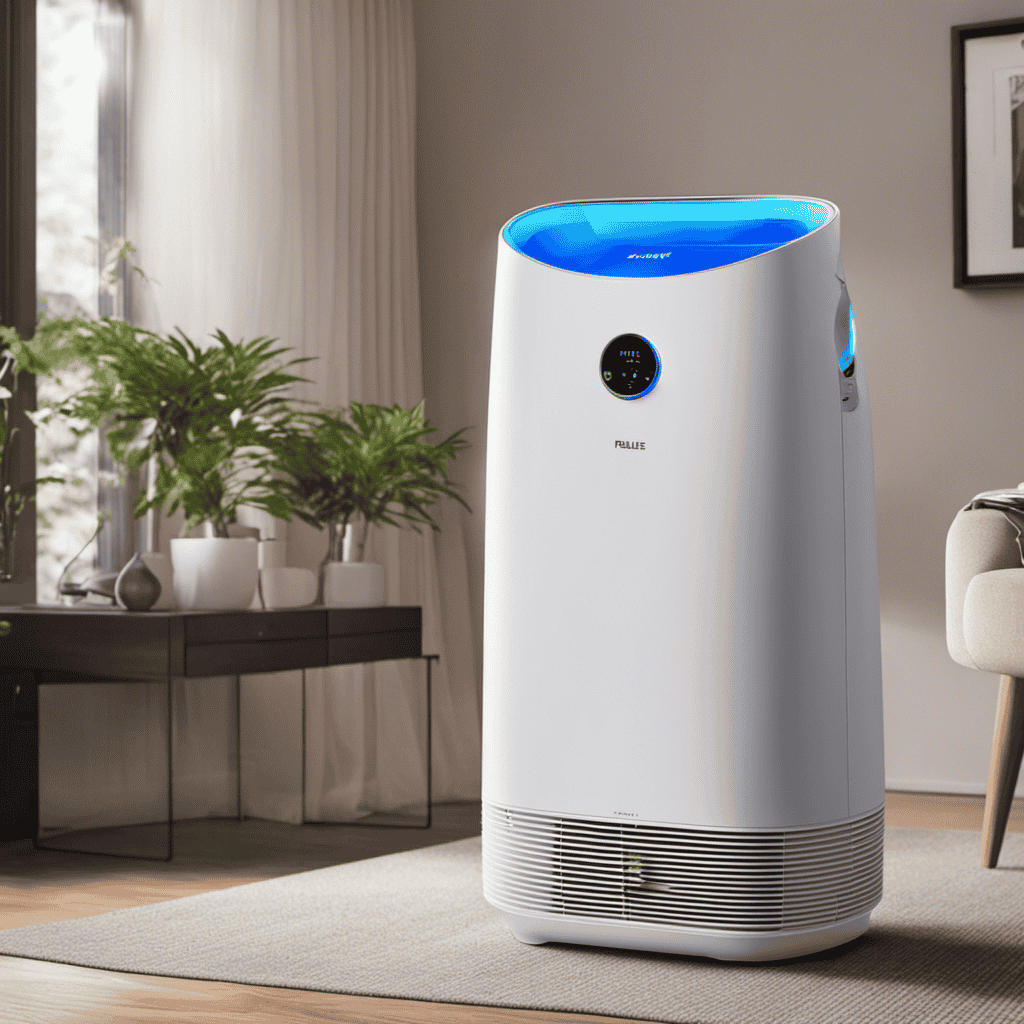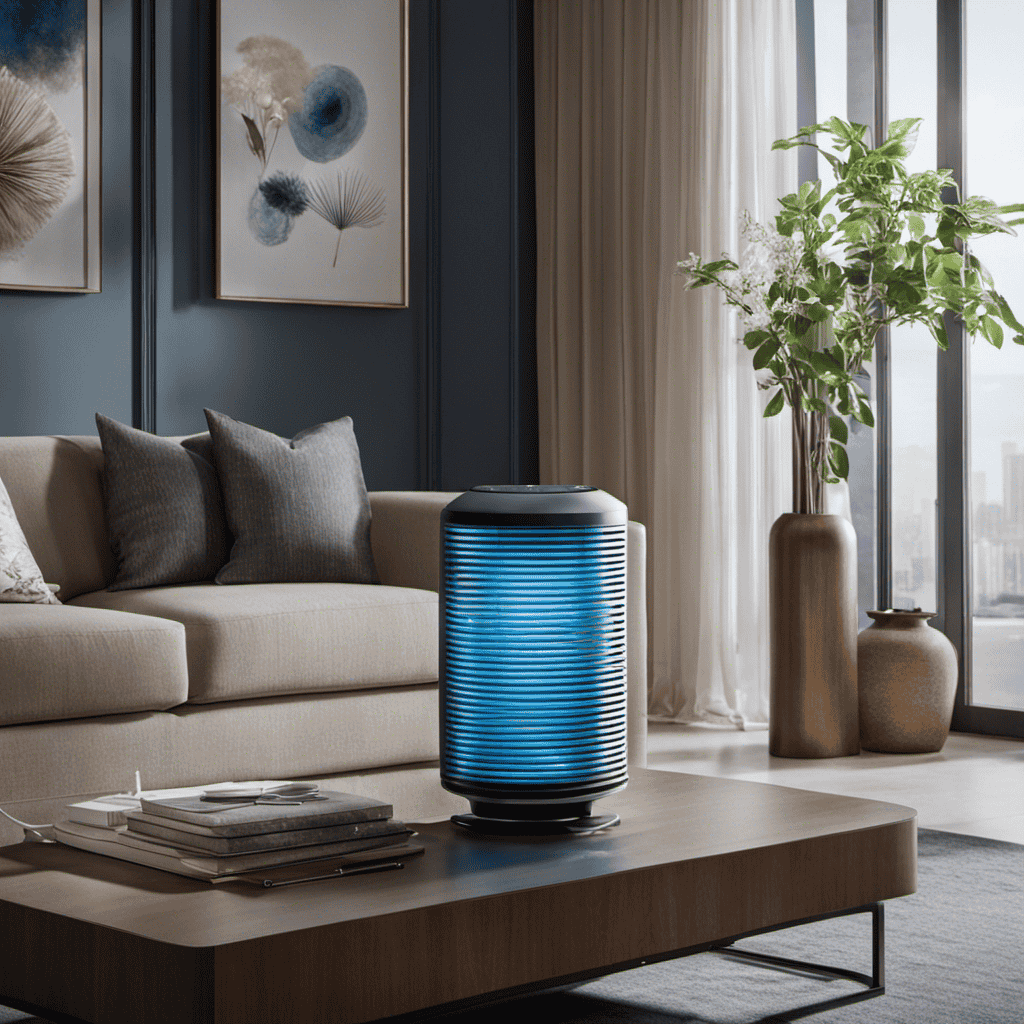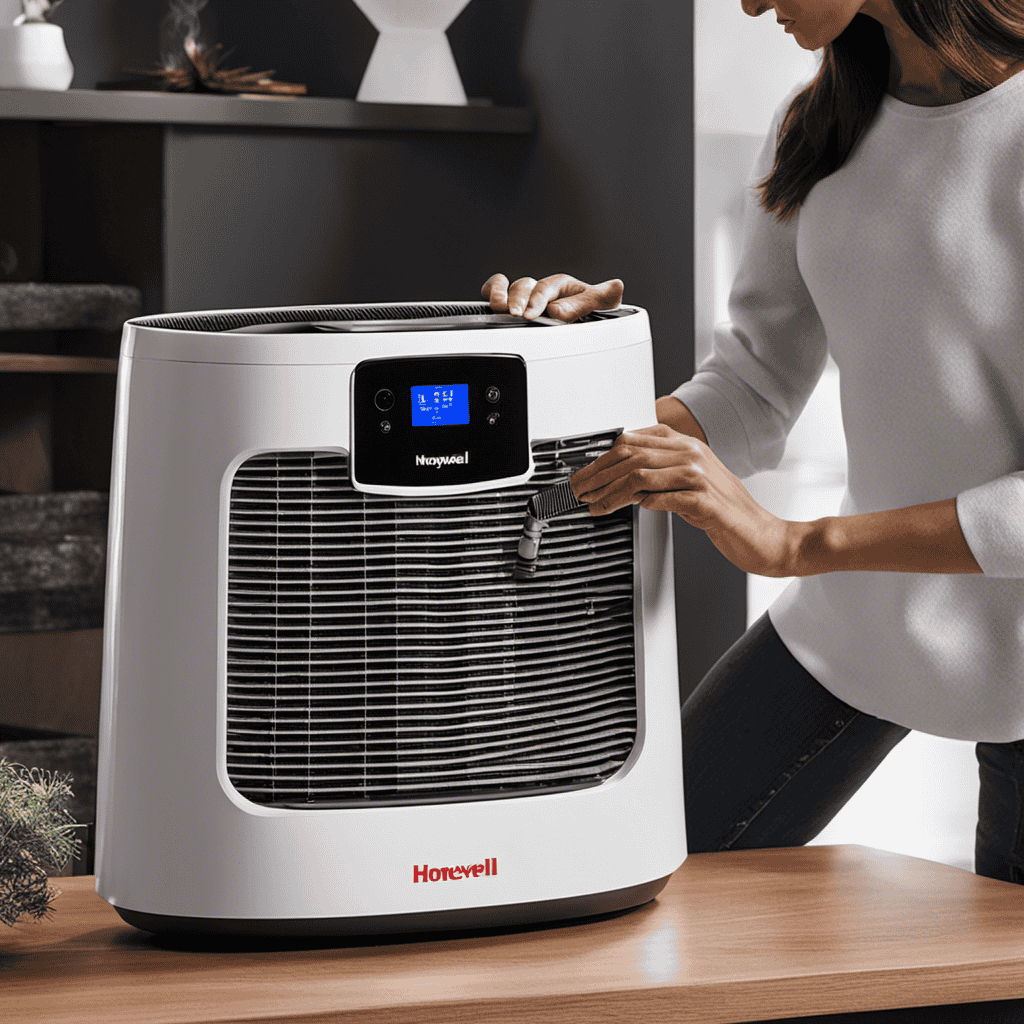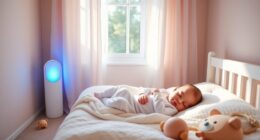Curious about UV Mode on air purifiers? Allow me to enlighten you on the topic.
UV Mode is a fascinating feature that plays a crucial role in the purification process. By harnessing the power of ultraviolet light, it effectively eliminates harmful bacteria, viruses, and other airborne contaminants.
In this article, we’ll delve into the functionality, benefits, and scientific principles behind UV Mode. Get ready to discover how this technology contributes to a healthier and cleaner living environment.
Key Takeaways
- UV mode on air purifiers uses ultraviolet light to target and destroy bacteria and viruses in the air.
- UV mode helps prevent filter clogging and extends the lifespan of the air purifier.
- UV mode effectively eliminates harmful microorganisms in the air and provides an additional layer of purification.
- Safety precautions should be followed when using UV mode, such as limiting exposure to UV-C rays and keeping children and pets away from activated areas.
The Role of UV Mode in Air Purifiers
If you’re wondering about the role of UV mode in air purifiers, it is designed to help eliminate bacteria and viruses in the air. UV mode utilizes ultraviolet (UV) light to target and destroy harmful microorganisms present in the air. This technology works by emitting UV-C radiation, which damages the genetic material of bacteria and viruses, rendering them unable to reproduce and causing their death.
One important aspect to consider when using UV mode is its impact on energy consumption. While UV mode does require additional energy to operate, it is typically minimal compared to the overall energy consumption of the air purifier. Therefore, the effect on energy consumption is generally negligible.
Additionally, UV mode can have a positive effect on the lifespan of an air purifier. By eliminating bacteria and viruses, it helps prevent the buildup of harmful microorganisms within the purifier’s filters. This reduces the risk of filter clogging and extends the overall lifespan of the air purifier.
Understanding the Functionality of UV Mode
When it comes to the effectiveness of UV mode in air purifiers, there are several key points to consider.
Firstly, UV mode is highly effective in eliminating harmful bacteria, viruses, and other microorganisms that may be present in the air. This is achieved through the use of ultraviolet light, which damages the DNA of these pathogens and renders them inactive.
Secondly, one of the major benefits of UV mode is its ability to provide an additional layer of purification, working in conjunction with other filtration technologies to ensure a cleaner and healthier indoor environment.
Lastly, it is important to note that while UV mode can be highly effective, there are certain safety considerations that need to be taken into account. It is crucial to follow the manufacturer’s instructions and guidelines to ensure proper usage and minimize any potential risks associated with UV exposure.
UV Mode Effectiveness
To determine the effectiveness of UV mode on your air purifier, you should consider the manufacturer’s recommendations and research scientific studies on its germ-killing capabilities.
When it comes to UV mode safety, it is important to follow the guidelines provided by the manufacturer. This may include wearing protective gear such as gloves and goggles when handling the air purifier with UV mode activated. Additionally, it is crucial to ensure that children and pets are not exposed to the UV light emitted by the purifier.
In terms of UV mode efficiency, scientific studies have shown that ultraviolet light can effectively kill certain types of bacteria, viruses, and mold spores. However, it is important to note that the effectiveness of UV mode may vary depending on factors such as the intensity and duration of exposure, the distance between the UV light source and the pathogens, and the overall design of the air purifier.
Benefits of UV Mode
One of the benefits of using UV mode on my air purifier is that it helps eliminate harmful bacteria, viruses, and mold spores. UV mode utilizes ultraviolet light to break down the DNA structure of these microorganisms, rendering them inactive and unable to reproduce. This technology is highly effective in neutralizing airborne pathogens and reducing the risk of respiratory infections.
In addition, the UV mode also helps to improve the overall air quality by reducing odors caused by bacteria and mold. It provides an extra layer of protection, especially in environments where there is a higher risk of contamination, such as hospitals, offices, and households with pets or individuals with compromised immune systems.
The effectiveness of UV mode in purifying the air makes it an essential feature for anyone concerned about air quality and respiratory health.
Safety Considerations for UV Mode?
Make sure you are aware of the safety considerations when using UV mode on your air purifier. While this mode can effectively eliminate harmful pathogens and bacteria in the air, it is important to follow precautions to ensure your safety.
Here are three important safety measures to keep in mind:
-
Limit Exposure: UV-C rays used in air purifiers can be harmful to the skin and eyes. Avoid direct exposure to UV light and make sure to turn off the UV mode before entering the room.
-
Keep Children and Pets Away: UV mode should be used in areas where children and pets cannot access. Ensure the air purifier is placed out of their reach to prevent accidental exposure.
-
Follow Manufacturer’s Instructions: Each air purifier may have specific guidelines for using the UV mode. Read the manual carefully and follow the recommended usage instructions to ensure safe and effective operation.
How Does UV Mode Work in Air Purifiers
When it comes to UV purifier effectiveness, it is important to understand how well these devices can actually eliminate harmful pathogens in the air.
Additionally, the safety of UV mode is another crucial aspect to consider, as it involves the use of ultraviolet light which can have potential risks if not used properly.
In this discussion, I will explore the effectiveness of UV purifiers in removing airborne contaminants and address the safety concerns associated with using UV mode in air purifiers.
UV Purifier Effectiveness
The UV purifier isn’t as effective as some might think. While it is true that UV purifier technology has the potential to eliminate certain harmful microorganisms, it is important to understand its limitations. Here are three reasons why UV purifiers may not be as effective as expected:
-
Limited range: UV purifiers primarily target airborne pathogens within close proximity. They are less effective in large spaces or areas with poor air circulation.
-
Ineffectiveness against particulate matter: UV purifiers are designed to kill microorganisms, but they do not remove particulate matter such as dust, pollen, or pet dander. A separate filtration system is required to address these particles.
-
Short exposure time: The effectiveness of UV light in killing microorganisms depends on the duration of exposure. In air purifiers, the air moves quickly past the UV light, limiting the exposure time and reducing its efficacy.
While UV purifiers can be a valuable addition to air filtration systems, it is important to consider their limitations and complement them with other technologies for comprehensive air purification.
Safety of UV Mode
One thing to consider is whether the UV mode is safe for prolonged use.
When it comes to the safety of UV mode on air purifiers, there are precautions that need to be taken into account. UV mode utilizes ultraviolet light to kill germs, bacteria, and viruses present in the air. While this can be effective in reducing airborne pathogens, it is important to remember that UV rays can be harmful to humans if exposed for extended periods.
To ensure safety, it is recommended to follow the manufacturer’s guidelines regarding UV mode usage. This may include precautions such as limiting exposure time, maintaining a safe distance from the device, and using protective measures like wearing UV-resistant glasses or gloves.
Benefits of Using UV Mode on Air Purifiers
Using UV mode on air purifiers can help eliminate harmful bacteria and viruses from the air. The role of UV-C light in air purification is crucial in this process. Here are three benefits of using UV mode on air purifiers:
-
Enhanced germ-killing: UV-C light has the ability to destroy the DNA structure of microorganisms, rendering them unable to reproduce or cause harm. By incorporating UV mode, air purifiers can effectively kill a wide range of bacteria and viruses, improving the overall air quality in your space.
-
Extended filter longevity: UV mode can also help extend the lifespan of the filters in air purifiers. By neutralizing harmful microorganisms, UV-C light reduces the accumulation of bacteria and viruses on the filters. This prevents clogging and allows the filters to function optimally for a longer period, reducing the need for frequent filter replacements.
-
Improved indoor air quality: By eliminating harmful bacteria and viruses, UV mode helps to create a healthier indoor environment. This is particularly beneficial for individuals with respiratory conditions or weakened immune systems, as it reduces their exposure to potential pathogens and promotes overall well-being.
The Science Behind UV Mode on Air Purifiers
UV light has the ability to kill germs, which is one of the key benefits of using UV mode on air purifiers.
In this discussion, I will explain how UV mode works and its effectiveness in eliminating harmful microorganisms.
Understanding the science behind UV mode will help us make informed decisions when it comes to choosing air purifiers for a cleaner and safer environment.
UV Light Kills Germs
You can activate the UV mode on your air purifier to effectively eliminate germs. Here’s how it works:
-
UV light sterilization: When you activate the UV mode, the air purifier emits ultraviolet (UV) light. This UV light has germicidal properties, meaning it can kill or inactivate microorganisms like bacteria, viruses, and mold spores.
-
Effectiveness of UV mode: Studies have shown that UV light can be highly effective in killing germs. It damages the DNA or RNA of microorganisms, preventing them from reproducing and causing infections. By using UV mode, you can ensure that the air in your room is free from harmful pathogens.
-
Additional purification: UV mode complements other purification methods of your air purifier, such as HEPA filtration. While HEPA filters can capture larger particles like dust and pollen, UV light can target smaller microorganisms that may pass through the filter. This combination provides a more comprehensive approach to air purification.
With the UV mode on your air purifier, you can be confident that your indoor air is not only clean but also free from harmful germs.
Benefits of UV Mode
When activated, the UV mode effectively eliminates germs and ensures a cleaner and safer indoor environment. The importance of UV-C light in air purification cannot be overstated.
UV-C light, with a wavelength between 200 and 280 nanometers, has been proven to be highly effective in killing bacteria, viruses, and other microorganisms. This powerful light disrupts the DNA and RNA of these harmful organisms, rendering them unable to reproduce and causing their eventual death.
When the UV mode is engaged, the air purifier uses UV-C light to neutralize these germs, providing an additional layer of protection against airborne pathogens. This has a significant impact on indoor air quality, as it reduces the presence of harmful microorganisms and helps prevent the spread of diseases.
How UV Mode Works
To understand how it works, it’s important to grasp the concept of UV-C light and its ability to neutralize harmful microorganisms.
In UV mode, an air purifier utilizes UV-C light to target and destroy bacteria, viruses, and mold spores in the air. Here are three key points to consider:
-
Effectiveness: UV-C light has been proven to be highly effective in killing a wide range of microorganisms by disrupting their DNA structure, rendering them unable to reproduce and cause harm.
-
Safety considerations: While UV-C light is effective, it’s important to use it safely. Some air purifiers have safety features like automatic shut-off when the device is opened or tilted to prevent UV-C light exposure to humans.
-
Continuous protection: UV mode provides continuous protection by continuously disinfecting the air as it passes through the purifier, ensuring that the air you breathe is clean and free from harmful microorganisms.
Understanding how UV mode works is crucial when comparing it to other air purification modes.
UV Mode Vs. Other Air Purification Modes
UV mode, compared to other air purification modes, is more effective at eliminating harmful bacteria and viruses from the air. The advantages of UV mode are that it utilizes ultraviolet light to destroy the DNA structure of microorganisms, rendering them unable to reproduce and causing their demise. This mode is highly efficient in sanitizing the air and reducing the risk of infections.
However, UV mode has its limitations. It is only effective against airborne pathogens that pass within close proximity of the UV lamp. Additionally, it is unable to remove larger particles such as dust or allergens from the air.
Therefore, it is recommended to use UV mode in conjunction with other air purification technologies to achieve optimal results in creating a clean and healthy indoor environment.
Is UV Mode Effective in Killing Bacteria and Viruses
I’ve always been curious about the efficacy of UV mode in killing bacteria and viruses. In order to understand its germicidal efficacy, it’s important to compare it with alternative methods of air purification.
UV Mode’s Germicidal Efficacy
Ensure that you’re aware of the germicidal efficacy of UV Mode on your air purifier. UV Mode plays a crucial role in reducing respiratory illnesses and improving air quality.
Here are three key points about UV Mode’s impact on air pollution and its role in reducing respiratory illnesses:
-
UV Mode eliminates harmful microorganisms: UV-C light emitted by the air purifier in UV Mode effectively kills bacteria, viruses, and mold spores, reducing the risk of respiratory infections and allergies caused by these airborne contaminants.
-
UV Mode reduces indoor air pollution: By neutralizing pollutants such as VOCs (volatile organic compounds) and odors, UV Mode helps improve indoor air quality, making it safer and healthier to breathe.
-
UV Mode complements filtration systems: While filters trap larger particles, UV Mode targets and destroys smaller microbes that may bypass the filtration process, providing an additional layer of protection against respiratory illnesses.
Understanding the germicidal efficacy of UV Mode is essential for maximizing the benefits of your air purifier and maintaining a clean and healthy indoor environment.
UV Mode Vs. Alternative Methods?
When comparing UV Mode to alternative methods, it is important to consider their effectiveness and impact on air quality.
UV Mode stands out when compared to ozone generators. While ozone generators can effectively eliminate harmful odors, they may release ozone gas into the air, which can be harmful to humans and pets.
On the other hand, UV Mode utilizes ultraviolet light to kill bacteria, viruses, and mold spores without generating any harmful byproducts.
When comparing UV Mode to HEPA filters, it is worth noting that HEPA filters can effectively trap large particles like dust and pollen, but they may not be as effective against smaller microorganisms.
UV Mode, on the other hand, can target and destroy these smaller pathogens, ensuring cleaner and healthier air.
UV Mode as a Complementary Technology in Air Purifiers
UV Mode is often used as a complementary technology in air purifiers to enhance the overall effectiveness of the device. This mode utilizes ultraviolet (UV) light to eliminate harmful viruses, bacteria, and other microorganisms present in the air. Here are three key benefits of UV Mode:
-
Enhanced Germ Elimination: UV light has the ability to penetrate the cell walls of microorganisms, damaging their DNA and preventing them from reproducing. This ensures a higher level of germ elimination in the air, reducing the risk of airborne diseases.
-
Odor Reduction: UV Mode can also help eliminate unpleasant odors caused by bacteria and mold. The UV light breaks down the organic compounds responsible for the odors, resulting in fresher and cleaner air.
-
Energy Efficiency: Unlike other purification methods, UV Mode operates without the need for additional filters or chemicals. This makes it a more energy-efficient and cost-effective solution for air purification.
However, it is important to note that UV Mode should be used with caution. Safety precautions such as wearing protective eyewear and ensuring that the device is properly shielded are necessary to prevent direct exposure to the UV light.
UV Mode, with its numerous benefits and safety precautions, plays a crucial role in improving indoor air quality.
UV Mode and Its Impact on Indoor Air Quality
In my previous discussion about UV Mode as a complementary technology in air purifiers, I highlighted its role in eliminating bacteria, viruses, and mold spores.
Now, let’s delve into the importance of UV Mode in air purification and its impact on respiratory health.
UV Mode plays a crucial role in ensuring cleaner and healthier indoor air. This mode utilizes ultraviolet light to destroy microorganisms that may be present in the air. By targeting the DNA of these harmful particles, UV Mode effectively neutralizes their ability to reproduce, rendering them harmless.
The impact of UV Mode on respiratory health cannot be overstated. By eliminating harmful pathogens, it reduces the risk of respiratory infections, allergies, and asthma flare-ups. Moreover, this mode helps to prevent the spread of airborne diseases, ensuring a safer environment for everyone.
UV Mode and Its Role in Allergy Relief
If you suffer from allergies, utilizing UV Mode in your air purifier can greatly alleviate your symptoms. UV Mode is a feature in air purifiers that utilizes ultraviolet (UV) light to target and neutralize airborne allergens such as pollen, dust mites, and pet dander.
Here are three ways UV Mode can benefit your respiratory health and help prevent mold growth:
-
Allergen Reduction: UV Mode effectively kills or deactivates allergens, reducing their presence in the air you breathe. This can significantly alleviate allergy symptoms, such as sneezing, itching, and congestion.
-
Mold Prevention: UV light has the ability to destroy mold spores, preventing their growth and spread. This is particularly important for individuals with mold allergies or respiratory conditions, as exposure to mold can worsen symptoms and lead to respiratory distress.
-
Improved Air Quality: By targeting and neutralizing allergens and mold spores, UV Mode helps improve the overall air quality in your home. This can provide relief not only for allergy sufferers but also for anyone concerned about maintaining a healthy indoor environment.
UV Mode as a Preventive Measure for Airborne Diseases
In my previous discussion on UV mode, I focused on its effectiveness in providing relief from allergies. Now, let’s delve into another aspect of UV mode – its role in preventing the spread of airborne diseases and its impact on respiratory health.
UV mode, when activated on an air purifier, emits ultraviolet (UV) light to target and destroy microorganisms like bacteria and viruses. This feature is particularly important in mitigating the risk of airborne infections. The UV light damages the DNA and RNA of these pathogens, rendering them unable to replicate and causing them to be inactive.
By eliminating these harmful microorganisms from the air, UV mode helps to improve respiratory health. It reduces the chances of inhaling infectious particles that can lead to respiratory illnesses. This is especially beneficial for individuals with weakened immune systems or those who are more susceptible to respiratory infections.
UV Mode and Its Effectiveness in Eliminating Odors
Activate UV mode on your air purifier to effectively eliminate odors in your home. UV mode utilizes ultraviolet light to target and neutralize odor-causing molecules, leaving your indoor air fresh and clean.
Here are three key points to consider regarding UV mode and its impact on energy consumption and its effectiveness against mold spores:
-
Energy Consumption: UV mode consumes minimal energy, making it an energy-efficient option for odor elimination. The UV light operates at a low wattage, ensuring that it doesn’t significantly contribute to your overall energy usage.
-
Effectiveness against Mold Spores: UV mode is highly effective at combating mold spores. The ultraviolet light kills the spores by breaking down their DNA, preventing their growth and spread. This helps in reducing the risk of mold-related health issues and maintaining a healthier indoor environment.
-
Additional Benefits: Besides eliminating odors, UV mode also helps in reducing the presence of other harmful microorganisms, such as bacteria and viruses. It provides an added layer of protection, promoting a hygienic living space for you and your family.
UV Mode and Its Contribution to a Healthy Living Environment
To create a healthier living environment, consider the contribution of UV mode on your air purifier in eliminating harmful microorganisms and reducing the risk of mold-related health issues. UV mode is a powerful feature that uses ultraviolet light to kill bacteria, viruses, and other pathogens present in the air. By incorporating UV mode into your air purifier, you can ensure that the air you breathe is clean and free from these harmful microorganisms. However, it is important to take certain safety precautions when using UV mode. Avoid direct exposure to the UV light and make sure to follow the manufacturer’s instructions for proper usage. By utilizing UV mode on your air purifier, you can enjoy the benefits of cleaner, healthier air without compromising your safety.
| UV Mode Benefits | UV Mode Safety Precautions |
|---|---|
| Eliminates harmful microorganisms | Avoid direct exposure to UV light |
| Reduces risk of mold-related health issues | Follow manufacturer’s instructions |
| Keeps air clean and free from pathogens | |
| Improves overall air quality | |
| Promotes a healthier living environment |
UV Mode and Its Potential in Reducing Airborne Allergens
Consider how using the UV mode on your air purifier can help reduce airborne allergens, providing you with cleaner and healthier air to breathe.
UV mode, commonly found in hospitals, utilizes ultraviolet light to deactivate and destroy microorganisms, such as bacteria and viruses, present in the air. Here are three key reasons why UV mode is effective in reducing airborne allergens:
-
Mold Prevention: UV mode helps prevent the growth of mold by targeting mold spores in the air. Mold spores can be a common trigger for allergies and respiratory issues, and UV light can effectively neutralize them, reducing the risk of mold-related health problems.
-
Elimination of Allergens: UV mode can effectively eliminate or deactivate common allergens, such as dust mites, pet dander, and pollen. By neutralizing these allergens, the air purifier can provide relief to individuals suffering from allergies and improve overall indoor air quality.
-
Enhanced Air Purification: In addition to capturing particulate matter through filtration, UV mode enhances the air purification process by deactivating harmful microorganisms. This dual approach ensures a more thorough and comprehensive purification of the air, making it safer and healthier to breathe.
UV Mode on Air Purifiers: an Overview of Its Features and Applications
When using UV mode on your air purifier, you can take advantage of its features and applications for a more efficient and effective air purification process. UV mode benefits include the ability to kill bacteria, viruses, and other harmful microorganisms in the air. This mode utilizes ultraviolet light to deactivate the DNA of these pathogens, rendering them unable to reproduce.
Additionally, UV mode can help reduce unpleasant odors by breaking down volatile organic compounds (VOCs) in the air. However, it is important to consider UV mode safety considerations. Direct exposure to UV light can be harmful to humans and pets, so it is crucial to ensure that the air purifier is designed with safety features such as shields or covers to prevent any accidental exposure.
It is also recommended to follow the manufacturer’s guidelines and instructions for safe usage of the UV mode.
Is the UV Mode on an Air Purifier the Same as the UV Button?
No, the UV mode on an air purifier is not the same as the UV button. The UV mode is a specific setting within the air purifier that activates the UV light to kill germs and bacteria, whereas the UV button is simply the button on the air purifier that controls the UV function.
Frequently Asked Questions
How Often Should the UV Mode Be Used on an Air Purifier?
UV mode should be used on an air purifier regularly to maximize its benefits. Cleaning and maintaining the UV mode is crucial for proper functioning. Regular usage and maintenance ensure effective elimination of harmful bacteria and viruses.
Can the UV Mode on an Air Purifier Be Harmful to Humans or Pets?
Using the UV mode on an air purifier can potentially be harmful to humans and pets. Precautions should be taken to minimize exposure and ensure safety. It’s important to compare the effectiveness of UV mode with other purification modes.
Is UV Mode Necessary if My Air Purifier Already Has Other Purification Modes?
UV mode is an additional layer of defense in air purification. Its effectiveness depends on the specific model. While it may offer benefits, weigh the pros and cons to determine if it’s necessary alongside other purification modes.
Can UV Mode on an Air Purifier Eliminate All Types of Bacteria and Viruses?
Yes, UV mode on an air purifier can effectively eliminate a wide range of bacteria and viruses. However, prolonged use of UV mode may pose potential risks, such as exposure to harmful UV radiation.
Does the Effectiveness of UV Mode on an Air Purifier Vary Depending on the Size of the Room?
In large or small rooms, the effectiveness of UV mode on an air purifier varies. It can eliminate various types of air pollutants, including bacteria and viruses, making it a valuable feature for ensuring clean indoor air.
Conclusion
In conclusion, the UV mode on air purifiers is a revolutionary feature that will transform your life in unimaginable ways.
This mode, with its cutting-edge technology, works tirelessly to annihilate odors, create a healthy living environment, and reduce airborne allergens.
It’s like having a superhero in your home, fighting off invisible enemies and leaving your air fresh and clean.
So, if you’re tired of breathing in stale air and want to experience the wonders of UV mode, it’s time to invest in an air purifier that will change your life forever.










